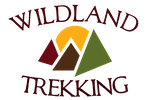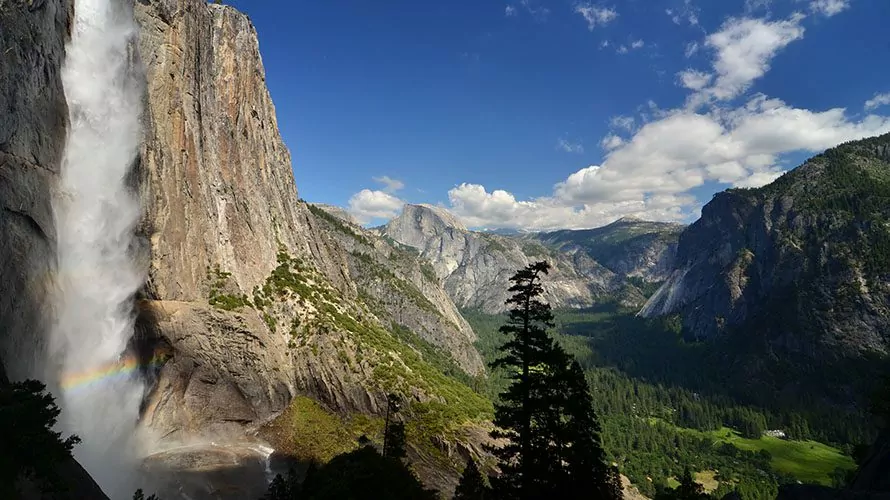
Yosemite Valley Basecamp Tour
Yosemite, California
Description
Our Spring/Fall Basecamp Tour in Yosemite Valley is a truly unique opportunity to experience the heart of Yosemite National Park in its best seasons. Lying at just 4,000 feet in elevation, “The Valley” has moderate winters, perfect shoulder seasons (spring and fall) and summers are quite hot. This trip allows our guests to enjoy the most comfortable seasons in the Park, a time that has the most impressive waterfall flows because of high mountain snowmelt (spring) and some of the most solitude one can find in the Valley!
We’ll set up a comfortable basecamp at a campground near Yosemite Valley and each day set out on hikes to waterfalls, amazing view points, edges of sheer cliffs, and more! Each evening we’ll return to camp for wonderful outdoor meals, campfires, and relaxation.
| Trip Type: Camping Hiking Tour |
Difficulty Level:
|
|
Solitude Level:
|
Group Size: 2-10 Guests |
| Trip Length: 4 Days | Distance: 20+MI / 32+KM |
|
Hiking Distances: 6-7 mi |
Backpack Weight: 8-12 lbs |
|
Terrain: Lightly Rugged |
Max Daily Elev. ↑↓: 2900 ft |
|
Heights Exposure: Moderate |
DIFFICULTY LEVEL 2
Scale of 1-5. 1 is least difficult; 5 is most difficult
This trip follows well maintained trails. Some concerns include loose dirt, large stepping stones and tree roots. The top of Vernal/Nevada falls has exposed vertical drops with safety railings in place.
Please Note: Terrain, Elevation Gain and Heights Exposure ratings reflect the section or day of the trip with the maximum difficulty of each. Much of the trip is at easier levels. See the trip itinerary for more detailed information.
PHYSICAL DEMANDS OF THIS TRIP
- Hiking uphill or downhill with a 8-12 lb backpack for 6-8 hours
- Maintaining balance and footing on lightly rugged terrain
- Hiking with occasional, moderate heights exposure
SOLITUDE LEVEL 2
1 least solitude, 5 most solitude
We rate this Yosemite trip a solitude 2. You can expect as much as an hour of solitude at a time.
Learn More about our Rating SystemWHAT’S INCLUDED
- Top-of-the-line tent, sleeping pad, sleeping bag, and day pack
- Use of trekking poles
- All meals are included from breakfast on Day 1 through lunch on the last day
- A professional, knowledgeable, certified Yosemite hiking guide
- Emergency equipment including a company-issued first-aid kit and communication device (InReach Explorer or satellite phone)
- Mandatory 5% national park fee that passes through directly to Yosemite
WHAT’S NOT INCLUDED
Day 1
- Hiking Mileage: 7.5 miles
- Elevation Gain: 2900 feet
- Elevation Loss: 2900 feet
On this Yosemite hiking tour, we’ll meet up the first morning of our trip at the Curry Village parking area in Yosemite Valley. From there, we start our hike to two of Yosemite’s crown jewels, Vernal Fall, and Nevada Fall, along either the John Muir Trail or the Mist Trail, depending on conditions. While many of Yosemite’s hikes are centered on a final destination, this route features stunning views the whole way, from Upper Yosemite Falls across the Valley, to the phenomenal granite heights of Liberty Cap, Grizzly Peak, the Panorama Cliffs, Sentinel Dome, Glacier Point and even Half Dome soaring above our heads.
After we lunch at a picturesque point overlooking the falls, we’ll make our way to the campground. As your guide prepares a sumptuous meal, there is time to is sit around the campfire and watch as the alpenglow turns a brilliant crimson in the sky above.
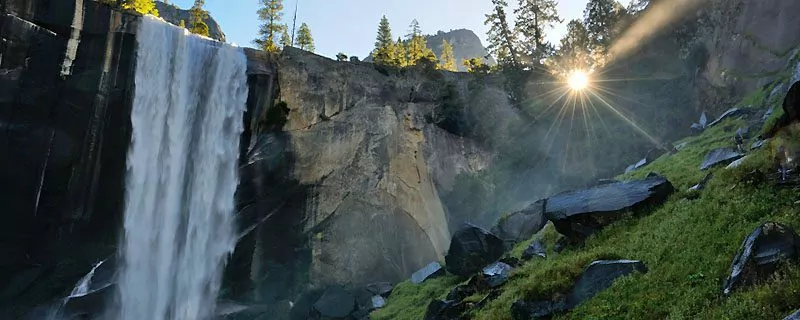
Day 2
- Hiking Mileage: 5.8 miles
- Elevation Gain/Loss: 3800 feet
Today we’ll tackle the Upper Yosemite Falls trail and ascend 3800 ft. to the North Rim of Yosemite Valley and the top of the sixth highest waterfall in the world! We begin our hike on the Valley floor at the historic Camp 4, where many of the legendary big wall climbers hung out in the 1950’s and 60’s. The trail ascends sharply from there as we make our way through oak/pine woodland that is prime habitat for bobcats. We soon reach Columbia Rock, with amazing views of Half Dome and the Clark Range across the Valley, before descending a bit to our first dramatic view of Yosemite Falls and the feel of cool mist on our faces. Continuing up a series of switchbacks, we top out on the Valley rim before descending a vertigo inducing stairway to the falls overlook. After a picnic lunch back at the rim we descend to the trailhead and our camp for a well-deserved gourmet dinner around the campfire.
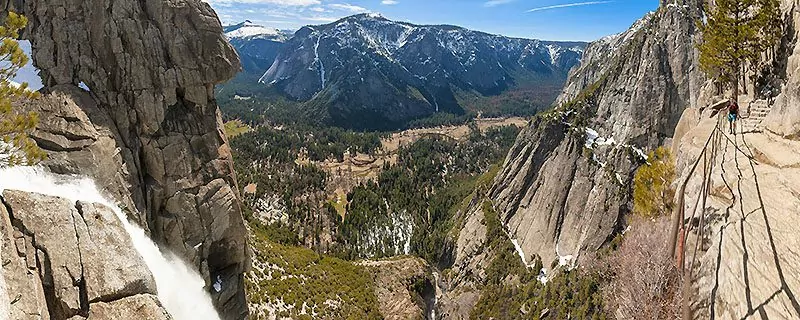
Day 3
- Hiking Mileage: Variable
- Elevation Gain/Loss: Variable
We’ll give our sore legs a break today and spend our time exploring the wonders of Yosemite Valley. After a hot breakfast and coffee in the chill spring air, we’ll collect our day packs and set off on the Valley Loop Trail. The possibilities are endless, as we can explore more popular sights as Bridalveil Fall and Mirror Lake; or, we can go off the beaten path to more obscure places like the Old Big Oak Flat Road with its one of a kind views of El Capitan or Sierra Point, the only place in Yosemite to see four major waterfalls. We’ll top off the day with a picnic dinner and experience one of the most beautiful sunsets possible.
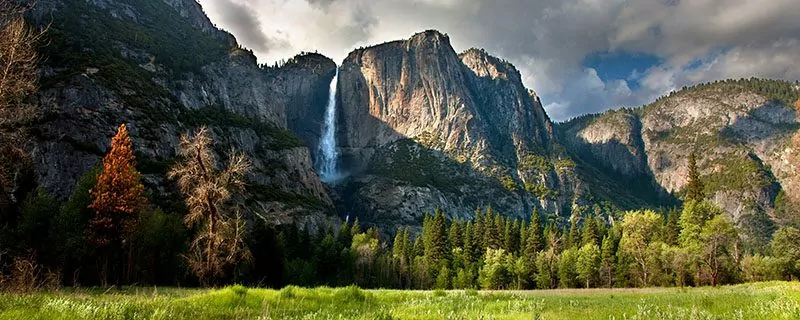
Day 4
- Hiking Mileage: 6.3 miles
- Elevation Gain/Loss: 1500 feet
On our final day, we’ll pack up and enjoy a hearty breakfast before leaving our basecamp among the ponderosa pines. We’ll turn south and enjoy one last, special treat. Today’s hike takes us into Yosemite’s biggest trees – the Mariposa Grove of Giant Sequoias. We’ll hike the lower and upper loops, which provide for a wonderful morning of hiking. We’ll visit the 2700 year old Grizzly Giant, the 25th largest tree on earth, as well as many other of these giants. We’ll also get an unparalleled view of Wawona Valley, another of Yosemite’s special places.
After our hike and lunch we’ll contemplate the unforgettable time we’ve just experienced, and most likely start hatching new plans for future trips to more special places like Yosemite!
Please Note: We always do everything in our power to follow the set itinerary, however it can change occasionally based on temporary access restrictions, weather, lodging/campground availability, guest ability/injury, natural events like fires and flooding, and other potential causes. Normal terms and conditions apply to trips with itinerary changes.
PACKING LISTS

IMPORTANCE OF BEING PREPARED
Your safety and enjoyment will depend on your level of preparedness. It is your responsibility to arrive with the items listed below. Our Gear Guide is a resource to find more information about these items and links to online options. If you have additional questions about what to pack, please ask your guide during the pre-trip contact (~10 days prior to the trip start date) or call our Adventure Consultants 7 days a week at 928-223-HIKE (4453).
STANDARD CLOTHING CHECKLIST
The following items are required for your trip unless otherwise noted. When packing, think layered clothing systems that work together and can be easily added or removed.
(GG) = Gear Guide: see for more info and links to product options
- Hiking Boots/Shoes – mid-weight, lug-soled, waterproof, and ideally well broken in (Boots GG – Shoes GG)
(Note: buy your boots/shoes 1/2 size to 1 size larger than your street shoes to allow for feet swelling and thicker socks) - Secondary Footwear – supportive, lightweight, well-drained shoe or sport sandal for creek crossings and/or for camp comfort (Camp Shoes GG)
- Hiking Socks – one pair for every two days of your trip, plus an extra pair to sleep in. Hiking-specific padded socks, no cotton, please! (Hiking Socks GG)
(Note: wearing thin liner socks under your hiking socks can help prevent blisters) - Sun Hat – wide brimmed hat or baseball cap/bandana combo (Sun Hats GG)
- Warm Hat & Gloves – lightweight beanie and light-to-mid weight fleece or wool gloves (GG)
- Hiking Shirts – non-cotton, breathable short sleeve and/or long sleeve shirts (Shirts GG – Sun Hoodies GG)
(Note: long sleeve shirts provide better sun protection) - Warm Top – mid-weight sweater or pullover of wicking material – merino wool, fleece or polypropylene (Mid Layers GG)
- Mid Layer Insulating Jacket – down-fill or synthetic-fill insulated “puffy” jacket or warm, heavy-weight fleece jacket (Mid Layers GG)
- Hiking Pants & Shorts – nylon pants AND shorts, zip-offs or leggings (Pants GG – Shorts GG)
- Rain Gear – waterproof jacket and pants, breathable fabric such as Gore-Tex® or coated nylon. For the pants look for side zippers that will allow you to pull them over your boots. (Rain Jackets GG – Rain Pants GG)
- Casual Clothing & Footwear – comfortable clothes and shoes for evenings off the trail
- Personal Luggage – small duffel bag, suitcase or backpack – for extra hiking clothes and casual clothes
Important Note: Please, no cotton hiking clothes and please feel free to call us if you have any questions or you can reference the Gear Guide.
GEAR CHECKLIST
- Hydration System – 2+ liters capacity, either water bottles or bladder/hose system and an additional water bottle (Hydration Bladders GG)
(Note: We recommend always having a bottle with 1 liter of capacity as a back-up in case of a hydration system failure and to use while in camp) - Headlamp – preferably with an L.E.D. bulb that works with AA or AAA batteries (Headlamps GG)
(Note: always test your headlamp before trips, travel/pack without batteries in device, and for longer trips (4+ days) consider a spare bulb and 1 set of spare batteries) - Contact Lenses and Glasses – if you wear contact lenses, please also bring a pair of glasses – your contacts are likely to become dirty and may be difficult to clean
- Sunglasses, Sunscreen, Lip Balm
- Bug Repellent – preferably a product containing at least 25% “DEET”
(Note: some people are sensitive to this product) - Toiletries
- Prescription Medication – please inform your trip leader of any medications you are taking
- 1-2 Face Masks (Recommended but Optional)
- Money – for any shopping you would like to do and for consideration of tipping your guide
(Note: tipping is optional but appreciated, industry recommendation is 10-20% of your trip cost based upon the quality of your experience)
OPTIONAL ITEMS
- Personal Trekking Poles – as a Wildland guest, you can enjoy a 20% discount off Leki trekking poles (reservation number required.) Click here for discount. Trekking poles are provided for guests who do not bring their own (Trekking Poles GG)
- Swimsuit
- Support Braces – consider bringing any joint braces that may be currently needed or from past injuries (i.e. knee, ankle, elbow, etc…)
- Vitamins & Supplements
TRAVEL, TRANSPORTATION, MEETING & LODGING

MEETING TIME & PLACE
You’ll meet your hiking guide and group in Curry Village in Yosemite Valley around 8 AM the morning the trip begins. Your guide will be in contact approximately 2 weeks before your trip and will specify the exact location of the rendezvous at that point. You can park your personal vehicle at Curry Village for the duration of the trip.
TRIP CONCLUSION
This trip will conclude at approximately 5:00 PM on the last day.
ARRIVAL AND DEPARTURE DATES
Travel to and from the trip starting point is not included in the cost of our trips. Please plan on arriving in time for the orientation meeting the day before the trip leaves (backpacking trips only) and departing the day after getting back from the field.
GATEWAY CITIES IN CALIFORNIA:
Fresno, Bakersfield, Merced, Sacramento, Oakland, San Franciso, San Jose, Visalia
GATEWAY CITIES OUTSIDE OF CALIFORNIA:
Reno, Nevada or Las Vegas, Nevada
BY RAIL AND BUS TO YOSEMITE
From Fresno: Yosemite Area Rapid Transit (YARTS) is offering 1 bus ride each direction from Fresno to Yosemite Valley.
From Other California Cities: by rail on the Amtrak San Joaquin Train to the city of Merced (serviced by most large cities in California) or by Amtrak “Thruway” Bus Service from Merced to Yosemite Valley. To book your trip, use Amtrak’s Online Reservation Service to book round-trip Amtrak travel to “YOS” (Yosemite Valley).
TRANSPORTATION TO & FROM THE TRAILHEAD
We will be utilizing Wildland Trekking vehicles as well as the Yosemite National Park Shuttle Service for transportation inside the park.
STORAGE OF PERSONAL ITEMS & VEHICLES
We recommend checking with your pre- and post-trip hotel(s) to inquire about luggage storage. Most of the time hotels are happy to accommodate. On this trip your vehicle can be parked at Curry Village or you can caravan to the east side of the Park and park your vehicle at our campground.
PRE & POST-TRIP RECOMMENDED LODGING
Pre and post-trip lodging is the guest’s responsibility.
Yosemite Valley Lodging
Website / 801-559-4884
Yosemite Lodge (in El Portal, 30 minutes from Yosemite Valley)
Website / 209-379-2681
Yosemite Blue Butterfly Inn (in El Portal, 30 minutes from Yosemite Valleyl)
Website / 209-379-2100
The Cedar Lodge (40 minutes from Yosemite Valley)
Website / 209-379-2612
Redwoods in Yosemite Vacation Rentals
Website / 877-753-8566
TRIP INSURANCE
We strongly recommend purchasing trip insurance. We designed our terms and conditions with trip insurance in mind. When you register for a trip, your spot is no longer available to other guests. Therefore, if you discover inside of 30 days (prior to your trip departure date) that you are unable to travel, no refund is available. With trip insurance, not only is your payment to Wildland covered, but your flights, hotels and other travel costs can also be insured.
Read more about our trip insurance recommendations.
CHECK THE WEATHER FORECAST FOR YOUR TRIP
We recommend using NOAA’s website (www.weather.gov) for the most accurate 5-day weather forecasts. There are two elevations to check when looking at Yosemite weather forecasts:

PACK WEIGHT AND CONTENTS
You will be hiking with a light day pack that we provide. You’re also welcome to bring your own. The contents will be what you need for the day – rain gear, an extra layer or two, snacks, water, sunscreen…etc.
ESTIMATED PACK WEIGHT: 8-12 POUNDS
ESSENTIAL ELIGIBILITY CRITERIA
Essential Eligibility Criteria (“EEC”) have been specifically identified to help you understand the skills and abilities necessary to participate on each Wildland trip, and they apply uniformly to all potential trip participants, irrespective of the presence or absence of any disability.
Once you identify a trip in which you may be interested, please carefully review the EEC and itinerary details. If after reviewing the EEC that apply to your desired trip, you determine you need an accommodation in order to meet the EEC, please contact us prior to registering to discuss your requested accommodation.
The EEC exist for your own safety and the safety and enjoyment of all participants. If you are unable to meet the EEC for the trip, with or without an accommodation, you are not eligible for that trip. If you register and arrive for a trip for which you do not meet the EEC, you will be disqualified from participation on the trip and will be dismissed or evacuated from the trip without a refund.
TRAINING TIPS

The better shape you’re in the more fun you’ll have! We recommend very strongly that you train for your trip.
TRAINING BY HIKING
If you have access to hiking trails in hilly or mountainous terrain, this is the ideal way to train. If not, we recommend using the Stairmaster machine (with rotating stairs like an escalator) or actually training on stairs. Nothing prepares you for a trip better than the activity itself!
Train at least 3 days a week. Start with short hikes or workouts (1-hour in length) with a light daypack. From week to week build the length and intensity of your hikes/workouts and gradually increase your pack weight until you’re comfortably able to hike 6-8 hours a day carrying the weight you’ll have on your trip. It’s best to begin your training regimen at least 12 weeks prior to your trip. Also be sure to use the boots you’ll have on your trip to break them in.
Following is how a program may look:
| First Week | Work Up To |
| Tuesday: 1-hour hike/workout with daypack Thursday: 1-hour hike/workout with daypack Sunday: 2-hour hike/workout with daypack |
Monday: 2-3 hour hike/workout with daypack Wednesday: 2-3 hour hike/workout with daypack Thursday: 2-3-hour hike/workout with daypack Sunday: 7-hour hike with the weight you’ll have on your trip |
SUPPLEMENTAL TRAINING IDEAS
There are many other activities that are easily incorporated into your daily life to build your overall fitness. Cross training is important to strengthen opposing muscle groups and it helps to avoid over-use injuries. Supplemental training ideas include:
- Bike to work or when running errands.
- Gym activities including step aerobics, treadmill, bicycling, or elliptical trainers to name a few. A modest weight training program focusing on the muscles that support the ankles, knees, back, and shoulders is also beneficial.
- Swimming is a great way to build endurance and cardiovascular fitness and is easy on the joints.
- Walk to work instead of driving. Run your errands by walking and carry your groceries home in a backpack.
- Yoga and/or Pilates classes can build strength throughout your body while also improving your flexibility.
- Intramural sports
- Jogging is another option, however if you are not a regular runner it can easily lead to injuries that backpacking may then exacerbate. Undertake a jogging routine with care.
FLEXIBILITY AND HYDRATION
Flexibility is an important part of training. Remember to stretch before and after your workouts. For the two weeks leading up to your trip cut your workouts in half to avoid arriving fatigued. Also for a 72-hour period before your trip commences, ensure that you are consuming sufficient amounts of sodium and fluids. Doctors agree that hikers increase the likelihood of experiencing problems if they are sodium depleted (e.g., follow a low sodium diet) or are dehydrated (due to travel or using diuretics such as coffee or alcohol).
Important note: Always consult with your physician before commencing with a workout program.
GROUP TRAVEL

If you’re joining one of our scheduled trekking tours you’ll be hiking with fellow outdoor enthusiasts. Please carefully examine the trip materials and difficulty level prior to registering to select a trip that matches your ability level. If you need assistance selecting the right trip we are more than happy to help.
We make every effort to accurately set expectations and effectively screen guests, however it is inevitable on some trips there will be a discrepancy in fitness levels. Consider that the trip may be a once in a lifetime opportunity for your fellow travelers and it is important to respect each guest’s individual condition, needs and desires.
Finally, guided groups are required by land management agencies to stay together on the trail. Hiking together can require patience and flexibility. If hiking at a very specific pace is extremely important to you, you may want to consider booking a private trip.
 TIPPING YOUR GUIDE
TIPPING YOUR GUIDE
Tipping your guide is greatly appreciated! Wildland guides, and outdoor/backcountry guides in general, do much more than lead guests down the trail. Although supported by amazing in-town staff, they often work independently in the field due to permit and logistical constraints. The guide is responsible for the group’s safety, menu planning (including dietary restrictions), cooking for the group, prepping and taking care of the gear, handling livestock (on stock-supported trips), driving, complying with government regulations, ensuring guest satisfaction, and generally making sure the tour runs smoothly. They wear many hats and are extraordinary at what they do!
The industry standard tip amount for hiking and backpacking guides is between 10% and 20% of the tour cost per person, depending on your level of satisfaction. If you have any questions about tipping, feel free to call us 7 days a week at 800-715-HIKE (4453)!

GUIDE SHIFTS
The guide(s) for this trip work daily shifts from 5 a.m. to 9 p.m. During off hours (9 p.m. to 5 a.m.) the guides’ time is their own, and they are free to sleep, rest, take personal time, postpone guest requests until the next morning, and any other legal, reasonable activity people engage in when not working. We ask all guests to respect the guides’ off-duty hours by not waking or asking anything of them unless there is a true emergency. Also, state law requires that employees receive an uninterrupted 10 minute break every four working hours, so guides are required to take four 10 minute breaks between 5 a.m. and 9 p.m.

Thank You! The Wildland Trekking Company is dedicated to delivering an exceptional travel experience that exceeds your every expectation. We believe travel and adventure are two of life’s great joys and take seriously our role in helping you create a trip of lasting memories. In addition to our role as your travel partner and outfitter we are dedicated to the promotion of stewardship and conservation in the regions we visit. One of our commitments is to use Wildland as a tool toward long-term sustainability of the Earth’s environment and its communities. If there is anything we can do to further inform or help you prepare for your upcoming adventure please do not hesitate to contact us. Thanks for the opportunity to serve you and we look forward to seeing you soon!

800-715-HIKE (4453)
Feel free to call us for more info – we’re here 7 days a week!

